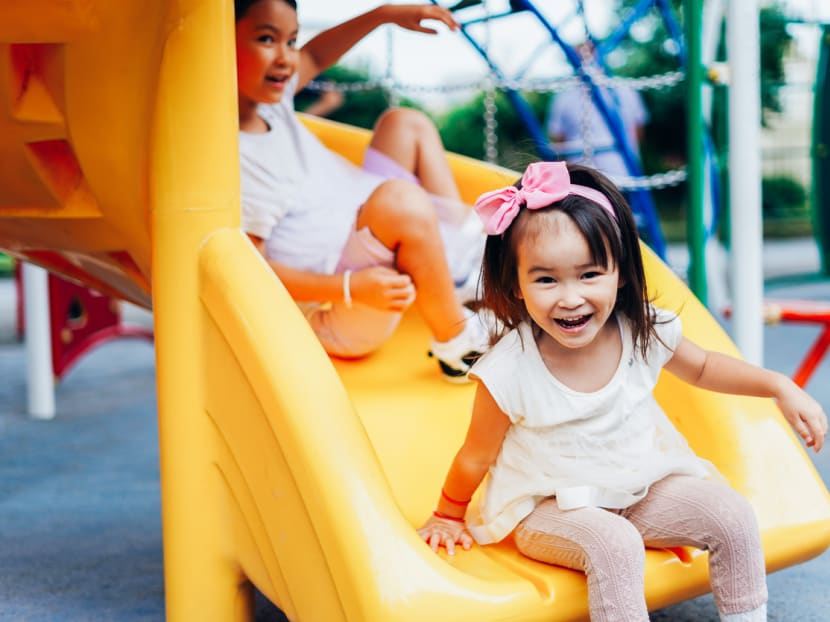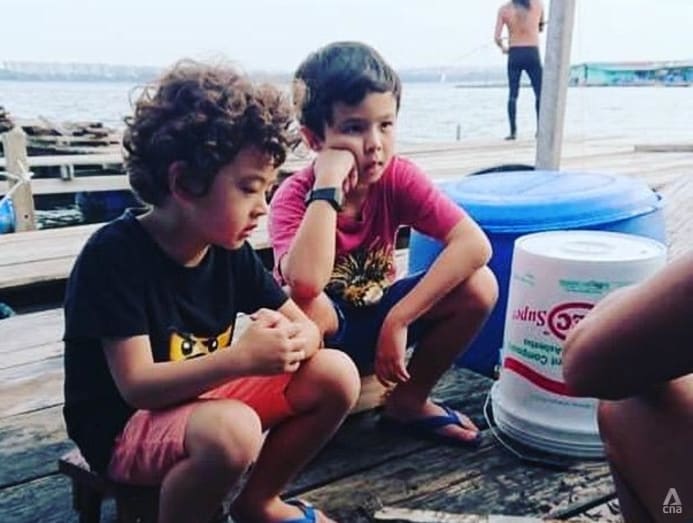Commentary: It’s timely to review unmasking our children
Nearly three years since the start of the COVID-19 pandemic, Singapore has reached a stage where the risks of prolonged masking of children may now outweigh the benefits, says Duke-NUS Medical School’s Vincent Pang.

File photo of children playing. (Photo: iStock/maroke)
SINGAPORE: Masks have been optional in most settings since Aug 29, but if you step into any classroom in Singapore, you will likely see a number of children with face coverings.
Some children have been happy to ditch their masks, others – or perhaps their parents – are keen to keep them on.
In this stage of the pandemic, are children still masking up even though it is not required because of the fear of getting COVID-19, peer pressure, or are they anxious about the transition?
RISKS OF PROLONGED MASKING
Nearly three years since the start of the COVID-19 pandemic and the evolution of mandatory mask mandates, we have reached a stage where the risks of prolonged masking of children may now outweigh the benefits.
Many of today’s children will have had formative childhood experiences behind their masks, in various stages of social isolation, and with an unprecedented reliance on the digital space, all in an effort to minimise their exposure to COVID-19.
While this has been a necessary approach, as we resume normalcy in our daily activities and with the roll out of the new vaccines and boosters for this age group, there are good reasons to unmask our children.
There is no disputing the effectiveness of masking to reduce the risk of symptomatic infections. Among adults, especially among healthcare professionals, studies have shown that masks are effective in reducing transmission.
Although findings on its efficacy among children remain limited and inconclusive, potentially due to ethical, recruitment and implementation challenges during the pandemic, it is fair to assume that masking in and of itself is helpful in guarding against infection in children too.
But we’ve also lived with COVID-19 for nearly three years now, and know much more about infection rates and how COVID-19 affects children.
Studies have also started to highlight the potential “side effects” of prolonged masking on the communication and social skills development, as well as psychological and emotional well-being of children.
While investigations on the longer-term impact are still pending, this suggests that the risks of prolonged masking may outweigh the benefits moving forward, especially when vaccines are made available to our children.
As Singapore Prime Minister Lee Hsien Loong said at the National Day Rally in August when he announced the relaxation of mask mandates: “Children do need to be able to see the facial expressions of their teachers and of each other ... It's crucial for their learning and development.”

LIVING WITH HIGH RISK OF EXPOSURE
As our young ones venture back into a world of physical interaction in classes and playgrounds, the reality is that the risk of SARS-CoV-2 exposure among children below 12 is likely to remain significant for a few reasons.
First, the vaccination coverage among children between ages five and 11 (ongoing since December last year) may not be able to sustain their herd immunity over time in Singapore without an equally high coverage of booster doses.
As of Nov 7, 75 per cent of children aged five to 11 have had two doses of the Pfizer-BioNTech/Comirnaty COVID-19 vaccine as their primary vaccination series, but only 6 per cent have received a booster dose to achieve the “minimum protection” as defined by the MOH.
A study by a group of paediatricians from the Khoo Teck Puat – National University Children’s Medical Institute at the National University Hospital (NUH) published in October showed that a third of parents in Singapore are hesitant to vaccinate their children against COVID-19.
This poor vaccine coverage trend is highly prevalent globally, although exacerbated in part due to limited availability and accessibility of vaccines.
With the increased demand for travelling among Singaporean families, the risk of exposure is also greater. According to Tripadvisor data, 84 per cent of Singaporeans are planning a vacation during the upcoming holiday season between December and February next year.
While vaccination helps to strengthen a person’s immune response, this is likely to wane progressively over time. Even with immune responses primed by natural infection among adults, the risk of reinfection would potentially only remain low for up to the next 16 months.
Without a sustainable protective level of immune responses to match the evolving variants through newer vaccines that provide better protection against them, the risk of transmission and exposure of SARS-CoV-2 is likely to increase in the community over time with increasing social activities and interactions.
BUT RISK OF SEVERITY IS LOWER THAN ADULTS
While being exposed to SARS-CoV-2 is difficult to avoid, it may not necessarily cause infection and severe disease outcomes, especially in children who are otherwise in good health.
Global studies have highlighted that among unvaccinated children, immunocompromised children with other health conditions such as cardiac, respiratory, or neurological ailments, and those who are obese or were premature at birth have a higher risk of COVID-19 severe outcomes, as compared to children without any of those conditions.
The risk of severe COVID-19 disease among children aged below 12 remains significantly lower than adults and the elderly globally. While hospitalisation and deaths among children due to COVID-19 have also been reported, the effectiveness of vaccinating our children to reduce the risk of severe COVID-19 disease is likely to be higher than prolonged masking our children.
CONSTANT GENOMIC SURVEILLANCE FOR EMERGING FATAL VARIANTS
When considering how to manage the risks of severe disease, a significant assessment tool for this is genomic surveillance.
This is critical to monitor the ability of the virus to mutate into strains that may cause severe disease. With constant random genetic mutation and animal-human spillover over time, novel and emerging variants may have acquired more efficient and destructive methods to cause severe disease by avoiding being detected and removed by the immune system promptly.
With the national, regional and global commitment to perform genomic surveillance and information sharing on SARS-CoV-2 and other priority pathogens, it provides timely risk assessments of emerging variants so that evidence-based intervention may be adopted promptly to protect our population, including our children.
Masking during this recovery phase may potentially be more “cost-beneficial” for children with respiratory symptoms or who are otherwise immunocompromised, but this should also be employed with empathy and flexibility.
Likewise for our children in potential vulnerable settings such as healthcare institutions, and in poorly ventilated and crowded environments.
It is important to note that masking alone will not eliminate the risk of exposure and infection, and sustaining good personal hand hygiene, responsible social behaviour and high vaccination coverage are equally critical to lower the risk of exposure.
All things taken into consideration, our children deserve to interact with all the smiles and facial expressions visible on their faces now more than ever, as part of their learning development.
Vincent Pang Junxiong is Visiting Assistant Professor, Centre for Outbreak Preparedness at Duke-NUS Medical School.











